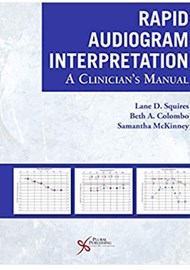This book is a manual and a workbook to systematically understand and interpret an audiogram for those who are new to audiometry such as residents, trainees and students. It is a worthy reference guide even to well-established practising clinicians.
The authors describe an eight-step guide to interpreting a person’s hearing status. To explain these, it is divided into four sections, namely Pure-Tone Audiometry, Speech Audiometry, Immittance Testing (Tympanometry and Acoustic Reflexes) and finally an Audiogram Workbook section.
The book explains the basics of PTA, Speech tests, Tympanometry and Acoustic Reflexes in simple and easy-to-understand language and diagrams. It has 65 audiograms with short case examples along with speech test, tympanometry and acoustic reflex data. It is spiral bound with an audiogram example and its interpretation on facing pages, so that the reader can test themselves on their interpretation skills, making it a good revision manual before sitting exams. This attempt to summarise a variety of basic-to-advanced scenarios gets a very good rating!
It is not a detailed book on auditory electrophysiology, and authors direct readers to other references. Despite this, it does not highlight auditory neuropathy spectrum disorder (ANSD) as a recognised retro-cochlear hearing disorder that can present with normal or abnormal audiograms and abnormal or absent acoustic reflexes, which should guide the reader to request auditory brainstem response (ABR) test to look at morphology of the ABR wave form and otoacoustic emissions and/or cochlear microphonics to confirm a diagnosis of ANSD. In the book, ANSD is mentioned on follow-up cases with a pre-diagnosis.
In general, the book achieves its aim to provide a rapid reference manual to those learning otology and audiology and provides value-for-money purchase in a trainee’s library.




